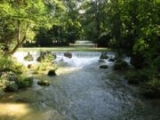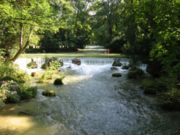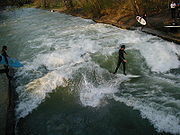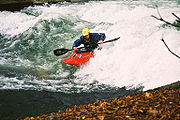
Eisbach
Encyclopedia

Munich
Munich The city's motto is "" . Before 2006, it was "Weltstadt mit Herz" . Its native name, , is derived from the Old High German Munichen, meaning "by the monks' place". The city's name derives from the monks of the Benedictine order who founded the city; hence the monk depicted on the city's coat...
. It flows through the park Englischer Garten and is a tributary of the Isar River. A manmade wave has been created on one section.
Swimming in the Eisbach is not allowed, but the rule is not enforced, and swimmers can be seen especially on warm summer days. At least two people have drowned in the lower part of the Eisbach, a swimmer in 2003 and a non-swimmer, who may have slipped or fallen asleep near the river, in February 2007.
Surfing on the Eisbach


Haus der Kunst
The Haus der Kunst is an art museum in Munich, Germany. It is located at Prinzregentenstrasse 1 at the southern edge of the Englischer Garten, Munich's largest park.-History:...
art museum, the river forms a standing wave
Standing wave
In physics, a standing wave – also known as a stationary wave – is a wave that remains in a constant position.This phenomenon can occur because the medium is moving in the opposite direction to the wave, or it can arise in a stationary medium as a result of interference between two waves traveling...
about 1 metre high, which is a popular river surfing
River surfing
River surfing is the sport of surfing either standing waves or tidal bores in rivers. Claims for its origins include a 1955 ride of 1.5 miles along the tidal bore of the River Severn...
spot. The water is cold and shallow (sometimes only 40 cm deep), making it suitable only for experienced surfers and playboaters
Playboating
Playboating is a discipline of whitewater kayaking or canoeing where the paddler performs various technical moves in one place , as opposed to downriver whitewater canoeing or kayaking where the objective is to travel the length of a section of river...
(whitewater kayakers). The wave is predominately used by surfers, and animosities of surfers towards kayakers (in general not uncommon) have occasionally been reported.
The wave has been surfed by river surfers since 1972, and surfing competitions have even been held. Due to the more recent development of playboating, kayakers have only more recently and so far not in great numbers started to surf the wave.
Surfing is now (2010) officially allowed. A new sign next to the wave warns that "Due to the forceful current, the wave is suitable for skilled and experienced surfers only". In previous years there have been issues between the authorities, who threatened to demolish the wave, and a group of wave supporters who organized activities and a website to save the wave, including an online petition to leave the wave intact.
Being a standing wave it can be surfed for as long as one's balance holds, and in busy times a queue of surfers forms on the bank. In the past surfers tied a leash to the bridge to hold onto, but a sign announces that this is both dangerous and forbidden.
The local surfers have forced the wave to break more cleanly, with increased height, by attaching ropes to the bridge which trail submerged planks, creating two large "U"-shapes. Such a shape makes the wave easier to surf for river surfers (playboating makes fewer demands of the wave shape).
A better wave for beginners is in Floßlände near the Thalkirchen U-Bahn station
Thalkirchen (Munich U-Bahn)
Thalkirchen is a Munich U-Bahn station in the Munich borough of Thalkirchen, near the Tierpark Hellabrunn ....
. It has also been surfed since 1972, and it is wide enough to take a few surfers at a time. A third standing wave in Munich forms on the Isar itself near the bridge Wittelsbacherbrücke, but only at flood levels of the river. Due to the dirt, manure and objects like tree branches drifting in the flood in the first days, this wave is usually surfed only a few days after the water level has risen.
External links
- Eisbach NEWS and interviews with the Munich river surfing community
- website "Save the Eisbach wave" (German, with English information)
- Bungee river surfing at the Eisbach by stahlnerv.de
- Surfen auf der stehenden Welle (and translation by google)
- Surfing at Eisbach by Markus Matern
- River Wave, Munich at surfxchange.net
- How to get there? Eisbach English Garden Munich
- Isar River Surf die Eisbach Wellenreiter am Haus der Kunst at ganz-muenchen.de (translation by google)
- Surfing the Eisbach, on kayaking
- Keep Surfing, Movie about Surfing on the Eisbach
- River surfing in Munich, on toytowngermany

